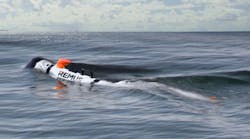MANASSAS, Va.-Aurora Flight Sciences has announced that its GoldenEye-50 unmanned aerial vehicle (UAV) performed multiple autonomous transitions from vertical to horizontal flight, and back again, during test flights.
The flights validate Aurora’s research, development, test, and evaluation of autonomous, ducted-fan UAVs with vertical takeoff and landing capabilities. GoldenEye-50, which Aurora announced in 2003 and first flew in July 2004, exhibits helicopter-like hover and vertical takeoff and landing performance as well as fuel-efficient, wing-borne flight similar to a conventional airplane.
This broad flight envelope provides operational flexibility not available in other small UAVs. During the transition flights, the aircraft accelerated to a forward velocity sufficient to make the aircraft’s wings provide primary lift and roll authority. The aircraft exhibited stable forward flight to a predetermined waypoint where it autonomously returned to a hover, turned 180 degrees, and returned to its launching area.
In December, the Defense Advanced Research Projects Agency (DARPA) selected a GoldenEye variant called GoldenEye-OAV as one of three vehicles concepts to compete for the Organic Air Vehicle-II procurement. The OAV-II UAV will provide a self-contained UAV capability for company-size units in the Army’s Future Combat System.
After one initial tether flight, the GoldenEye-50 made its first free flight in July 2004. Since then, the GoldenEye-50 aircraft have completed more than 30 test missions in a variety of weather conditions. All flights have been fully autonomous, using a GS-111M from Athena Technologies as the flight control system. There are currently three GoldenEye-50 UAVs in various stages of flight testing.
During the flight, the UAV used the GuideStar integrated flight control and navigation system (FCS/INS) from Athena Technologies Inc.
The miniature GS-111m GuideStar weighs just 7 ounces and performs fully autonomous navigation and flight control missions with the GoldenEye-50, from automated vertical takeoff and landing through high-speed, hover, loiter, and payload pointing flight.
Athena originally demonstrated the capability embodied in the GuideStar system in 2001/2002 for the DARPA Organic Air Vehicle (OAV) program and has continued to enhance the performance and capabilities of the GuideStar product line as it supplies FCS/INS solutions to the U.S. Army Shadow TUAV, Air Force BQM-167 target, and Alenia Aeronautica SKY-X UCAV programs, among others.
The demonstration flights were performed as part of an ongoing envelope expansion program with DARPA, says Dr. Dave Vos, chief executive officer and chief technical officer of Athena Technologies.
“The overarching goal here is to demonstrate that it is possible to provide a navigation and control system that can exploit the full envelope capabilities of the ducted fan class of Vertical Takeoff and Landing (VTOL) vehicles to provide a versatile airborne platform for the end user,” said Vos. “Athena has a very successful history of providing navigation and control solutions for all classes of UAVs, and we steadily continue to demonstrate that our technology and ability to deliver solutions on schedule, as well as at a very aggressive life-cycle cost, is second to none in the industry.”
For more information, see www.athenati.com.


